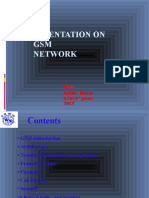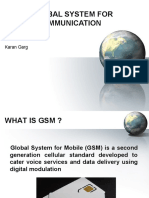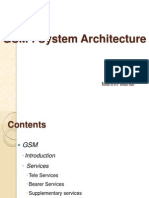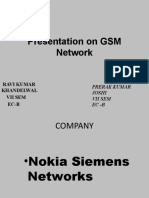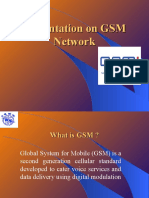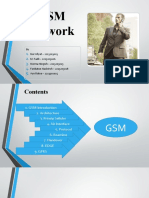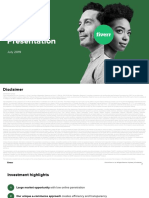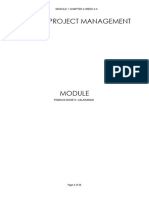Presentation on GSM Network
What is GSM ?
Global System for Mobile (GSM) is a second generation cellular standard developed to cater voice services and data delivery using digital modulation
� Developed by Group Spciale Mobile (founded 1982) which was an
initiative of CEPT ( Conference of European Post and Telecommunication )
Aim : to replace the incompatible analog system Presently the responsibility of GSM standardization resides with special mobile group under ETSI ( European telecommunication Standards Institute )
GSM: History
Full set of specifications phase-I became available in 1990
Under ETSI, GSM is named as Global System for Mobile communication Today many providers all over the world use GSM (more than 135 countries in Asia, Africa, Europe, Australia, America)
�GSM: History
Origins debatable but .
1887 - Hertz demonstrates EM waves 1896 - Marconi demonstrates wireless telegraph apparatus 1901 - First radio signal across the Atlantic (Cornwall to Newfoundland) 1914 - First wireless voice transmission 1946 - PSTN augmented with wireless 1947 - Cellular Network proposed
�GSM in World
Figures: March, 2005 3% 3% (INDIA) 4% 3% 3% 37% 4% Arab World Asia Pacific Africa East Central Asia Europe Russia 43% 1% India North America South America
�GSM Services
Tele-services Bearer or Data Services Supplementary services
�Tele Services
Telecommunication services that enable voice communication
via mobile phones Offered services
- Mobile telephony - Emergency calling
�Supplementary Services
Call related services : Call Waiting- Notification of an incoming call while on the handset
Call Hold- Put a caller on hold to take another call
Call Barring- All calls, outgoing calls, or incoming calls Call Forwarding- Calls can be sent to various numbers defined by the user Multi Party Call Conferencing - Link multiple calls together CLIP Caller line identification presentation
CLIR Caller line identification restriction CUG Closed user group
�Bearer Services
Include various data services for information transfer between GSM and other networks like PSTN, ISDN etc at rates from 300 to 9600 bps Short Message Service (SMS) up to 160 character alphanumeric data transmission to/from the mobile terminal
Unified Messaging Services(UMS)
Group 3 fax Voice mailbox Electronic mail
�GSM System Architecture
BSC PSTN MSC GMSC
MS
BTS
BTS MS BTS
BSC
VLR EIR
AUC
MS
HLR
�GSM System Architecture-I
Mobile Station (MS) Mobile Equipment (ME) Subscriber Identity Module (SIM) Base Station Subsystem (BSS) Base Transceiver Station (BTS) Base Station Controller (BSC) Network Switching Subsystem(NSS) Mobile Switching Center (MSC) Home Location Register (HLR) Visitor Location Register (VLR) Authentication Center (AUC) Equipment Identity Register (EIR)
�System Architecture Mobile Station (MS)
The Mobile Station is made up of two entities:
1. 2.
Mobile Equipment (ME) Subscriber Identity Module (SIM)
�System Architecture Mobile Station (MS)
Mobile Equipment
Portable,vehicle mounted, hand held device Uniquely identified by an IMEI (International Mobile Equipment Identity) Voice and data transmission Monitoring power and signal quality of surrounding cells for optimum handover Power level : 0.8W 20 W 160 character long SMS.
�System Architecture Mobile Station (MS) contd.
Subscriber Identity Module (SIM)
Smart card contains the International Mobile Subscriber Identity (IMSI) Allows user to send and receive calls and receive other subscribed services Encoded network identification details - Key Ki,Kc and A3,A5 and A8 algorithms Protected by a password or PIN Can be moved from phone to phone contains key information to activate the phone
�System Architecture Base Station Subsystem (BSS)
Base Station Subsystem is composed of two parts that communicate across the standardized Abis interface allowing operation between components made by different suppliers 1. 2. Base Transceiver Station (BTS) Base Station Controller (BSC)
�System Architecture Base Station Subsystem (BSS)
Base Transceiver Station (BTS):
Encodes,encrypts,multiplexes,modulates and feeds the RF signals to the antenna. Frequency hopping Communicates with Mobile station and BSC Consists of Transceivers (TRX) units
�System Architecture Base Station Subsystem (BSS)
Base Station Controller (BSC)
Manages Radio resources for BTS Assigns Frequency and time slots for all MSs in its area Handles call set up Transcoding and rate adaptation functionality Handover for each MS Radio Power control It communicates with MSC and BTS
�System Architecture Network Switching Subsystem(NSS)
Mobile Switching Center (MSC) Heart of the network Manages communication between GSM and other networks Call setup function and basic switching Call routing Billing information and collection Mobility management - Registration - Location Updating - Inter BSS and inter MSC call handoff MSC does gateway function while its customer roams to other network by using HLR/VLR.
�System Architecture Network Switching Subsystem
Home Location Registers (HLR)
- permanent database about mobile subscribers in a large service area(generally one per GSM network operator) - database contains IMSI,MSISDN,prepaid/postpaid,roaming restrictions,supplementary services.
Visitor Location Registers (VLR)
- Temporary database which updates whenever new MS enters its area, by HLR database - Controls those mobiles roaming in its area - Reduces number of queries to HLR - Database contains IMSI,TMSI,MSISDN,MSRN,Location Area,authentication key
�System Architecture Network Switching Subsystem
Authentication Center (AUC)
- Protects against intruders in air interface - Maintains authentication keys and algorithms and provides security triplets ( RAND,SRES,Kc) - Generally associated with HLR
Equipment Identity Register (EIR)
Database that is used to track handsets using the IMEI (International Mobile Equipment Identity) - Made up of three sub-classes: The White List, The Black List and the Gray List - Only one EIR per PLMN
-
�GSM Specifications-1
RF Spectrum GSM 900 Mobile to BTS (uplink): 890-915 Mhz BTS to Mobile(downlink):935-960 Mhz Bandwidth : 2* 25 Mhz
GSM 1800 Mobile to BTS (uplink): 1710-1785 Mhz BTS to Mobile(downlink) 1805-1880 Mhz Bandwidth : 2* 75 Mhz
�GSM Specification-II
Carrier Separation : 200 Khz Duplex Distance : 45 Mhz No. of RF carriers : 124 Access Method : TDMA/FDMA Modulation Method : GMSK Modulation data rate : 270.833 Kbps
�Speech
GSM Operation
Speech
Speech coding 13 Kbps Channel Coding 22.8 Kbps
Speech decoding
Channel decoding
Interleaving
22.8 Kbps Burst Formatting
De-interleaving
Burst Formatting
33.6 Kbps
Ciphering 33.6 Kbps De-ciphering
Modulation
Radio Interface
270.83 Kbps
Demodulation
�Call Routing
Call Originating from MS Call termination to MS
�Outgoing Call
1.
MS sends dialled number to BSS 2. BSS sends dialled number to MSC 3,4 MSC checks VLR if MS is allowed the requested service.If so,MSC asks BSS to allocate resources for call. 5 MSC routes the call to GMSC 6 GMSC routes the call to local exchange of called user 7, 8, 9,10 Answer back(ring back) tone is routed from called user to MS via GMSC,MSC,BSS
�1. Calling a GSM
Incoming Call
subscribers 2. Forwarding call to GSMC 3. Signal Setup to HLR 4. 5. Request MSRN from VLR 6. Forward responsible MSC to GMSC 7. Forward Call to current MSC 8. 9. Get current status of MS 10.11. Paging of MS 12.13. MS answers 14.15. Security checks 16.17. Set up connection
�Handovers
Between 1 and 2 Inter BTS / Intra BSC Between 1 and 3 Inter BSC/ Intra MSC Between 1 and 4 Inter MSC
�Security in GSM
On air interface, GSM uses encryption and TMSI instead of IMSI. SIM is provided 4-8 digit PIN to validate the ownership of SIM 3 algorithms are specified : - A3 algorithm for authentication - A5 algorithm for encryption - A8 algorithm for key generation
�Characteristics of GSM Standard
Fully digital system using 900,1800 MHz frequency band.
TDMA over radio carriers(200 KHz carrier spacing. 8 full rate or 16 half rate TDMA channels per carrier. User/terminal authentication for fraud control. Encryption of speech and data transmission over the radio path. Full international roaming capability. Low speed data services (upto 9.6 Kb/s). Compatibility with ISDN. Support of Short Message Service (SMS).
�Advantages of GSM over Analog system
Capacity increases Reduced RF transmission power and longer battery life. International roaming capability. Better security against fraud (through terminal validation and user authentication). Encryption capability for information security and privacy. Compatibility with ISDN,leading to wider range of services
�GSM Applications
Mobile telephony GSM-R Telemetry System - Fleet management - Automatic meter reading - Toll Collection - Remote control and fault reporting of DG sets Value Added Services
�Future Of GSM
2nd Generation GSM -9.6 Kbps (data rate)
2.5 Generation ( Future of GSM) HSCSD (High Speed ckt Switched data) Data rate : 76.8 Kbps (9.6 x 8 kbps) GPRS (General Packet Radio service) Data rate: 14.4 - 115.2 Kbps EDGE (Enhanced data rate for GSM Evolution) Data rate: 547.2 Kbps (max) 3 Generation WCDMA(Wide band CDMA) Data rate : 0.348 2.0 Mbps
�Thanks !
�Questions ?






